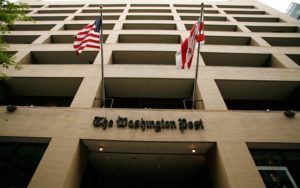By Robert Parry
In the
anti-Russian frenzy
sweeping American politics and media, Democrats, liberals and
mainstream pundits are calling for an investigative body that could
become a new kind of House Un-American Activities Committee to hunt down
Americans who have communicated with Russians.
The proposed commission would have broad subpoena powers to
investigate alleged connections between Trump’s supporters and the
Russian government with the apparent goal of asking if they now have or
have ever talked to a Russian who might have some tie to the Kremlin or
its intelligence agencies.
Such an admission apparently would be prima facie evidence of
disloyalty, a guilt-by-association “crime” on par with Sen. Joe
McCarthy’s Cold War pursuit of “communists” who supposedly had
infiltrated the U.S. government, the film industry and other American
institutions.
Operating parallel to McCarthy’s Red Scare hearings was the House
Un-American Activities Committee (or HUAC), a standing congressional
panel from 1945-1975 when it was best known for investigating alleged
communist subversion and propaganda. One of its top achievements was the
blacklisting of the “Hollywood Ten” whose careers in the movie industry
were damaged or destroyed.
Although the Cold War has long been over – and Russia has often
cooperated with the U.S. government, especially on national security
issues such as supplying U.S. troops in Afghanistan – Democrats and
liberals seem ready to force Americans to again prove their loyalty if
they engaged in conversations with Russians.
Or perhaps these “witnesses” can be entrapped into perjury charges if
their recollections of conversations with Russians don’t match up with
transcripts of their intercepted communications, a tactic similar to
ones used by Sen. McCarthy and HUAC to trip up and imprison targets over
such secondary charges.
Ousted National Security Advisor Michael Flynn has already
encountered such a predicament because he couldn’t recall all the
details of a phone conversation with Russian Ambassador Sergey Kislyak
on Dec. 29, 2016, after Flynn took
the call while vacationing in the Dominican Republic.
When Obama administration holdovers at the Justice Department decided
to gin up a legal premise to go after Flynn, they cited the Logan Act, a
law enacted in 1799 to prohibit private citizens from negotiating with
foreign adversaries but never used to convict anyone. The law also is of
dubious constitutionality and was surely never intended to apply to a
president-elect’s advisers.
However, based on that flimsy pretext, FBI agents – with a transcript
of the electronic intercept of the Kislyak-Flynn phone call in hand –
tested Flynn’s memory of the conversation and found his recollections
incomplete. Gotcha – lying to the FBI!
Under mounting
media and political pressure,
President Trump fired Flynn, apparently hoping that tossing Flynn
overboard to the circling sharks would somehow calm the sharks down.
Instead, blood in the water added to the frenzy.
Iran-Contra Comparison
Some prominent Democrats and liberals have compared Trump-connected
contacts with Russians to President Richard Nixon’s Watergate scandal or
President Reagan’s Iran-Contra Affair, an issue that I know a great
deal about having helped expose it as a reporter for The Associated
Press in the 1980s.
The key difference is that Iran-Contra was an unconstitutional effort
by the Reagan administration to finance an illegal war against
Nicaragua’s Sandinista government in defiance of a congressional ban.
The Trump-connected communications with Russians – to the degree they
have occurred – appear to have been aimed at preventing a new and
dangerous Cold War that could lead to a nuclear holocaust.
In other words, Iran-Contra was about enabling a paramilitary force
to continue its brutal marauding inside a country that was no threat to
the United States while the current “scandal” is about people trying to
avoid hostilities between two nuclear superpowers, an existential threat
that many mainstream and liberal pundits don’t want to recognize.
Indeed, there is a troubling denial-ism about the risks of an
accidental or intentional war with Russia as the U.S. media and much of
Official Washington’s establishment have lots of fun demonizing Russian
President Vladimir Putin and jabbing the Russians by shoving NATO troops
up to their borders and deploying anti-ballistic missiles in Eastern
Europe. For some crazy reason, the Russians feel threatened.
False Narratives
This Russia-bashing and Russia-baiting have been accompanied by false
narratives presented in the major U.S. newspapers, including The New
York Times and The Washington Post, to justify increased tensions.
For instance, the Post’s senior foreign affairs writer Karen DeYoung on Friday
described
the civil war in Ukraine this way: “That conflict began when Russia
invaded and annexed Crimea in 2014, then backed separatists in eastern
Ukraine in what has become a grinding war, despite a deal to end it,
called the Minsk agreement, negotiated with Putin by the leaders of
France and Germany.”
But DeYoung’s synopsis is simply not true. The crisis began in the
fall of 2013 when Ukraine’s elected President Viktor Yanukovych backed
out of what he regarded as a costly and unacceptable association
agreement with the European Union, a move which prompted protests by
Ukrainians in Kiev’s Maidan square.
The Obama administration’s State Department, U.S. neocon politicians
such as Sen. John McCain, and various U.S.-backed “non-governmental
organizations” then stoked those protests against Yanukovych, which grew
violent as trained ultra-nationalist and
neo-Nazi street fighters poured in from western Ukraine.
In early 2014, a coup to overthrow the democratically elected
Yanukovych took shape under the guidance of U.S. Assistant Secretary of
State Victoria Nuland and U.S. Ambassador to Ukraine Geoffrey Pyatt who
were caught in
a phone call in late January or early February 2014 conspiring to impose new leadership inside Ukraine.
Nuland disparaged a less extreme strategy favored by European
diplomats with the pithy remark: “Fuck the E.U.” and went on to declare
“Yats is the guy,” favoring Arseniy Yatsenyuk as the new leader. Nuland
then pondered how to “glue this thing” while Pyatt ruminated about how
to “midwife this thing.”
On Feb. 20, 2014, a mysterious sniper apparently firing from a
building controlled by the ultranationalist Right Sektor killed both
police and protesters, setting off a day of violence that left about 70
people dead including more than a dozen police.
The next day, three European governments struck a deal with
Yanukovych in which he agreed to early elections and accepted reduced
powers. But that political settlement wasn’t enough for the U.S.-backed
militants who stormed government buildings on Feb. 22, forcing
Yanukovych and his officials to flee for their lives.
Instead of standing by the Feb. 21 agreement, which the European
nations had “guaranteed,” Nuland pushed for and got U.S. allies to
accept the new post-coup regime as “legitimate,” with Yatsenyuk becoming
prime minister and
several top government posts given to the ultranationalists and neo-Nazis.
Spreading Violence
In the ensuing days, the right-wing violence spread beyond Kiev,
prompting Crimea’s legislature to propose secession from Ukraine and
readmission to Russia, whose relationship to the peninsula dated back to
Catherine the Great.
Nazi symbols on helmets worn by members of Ukraine’s Azov battalion. (As filmed by a Norwegian film crew and shown on German TV)
Crimea scheduled a referendum that was opposed by the new regime in
Kiev. Russian troops did not “invade” Crimea because some 20,000 were
already stationed there as part of a basing agreement at the Black Sea
port of Sevastopol. The Russians did provide security for the referendum
but there was no evidence of intimidation as the citizens of Crimea
voted by 96 percent to leave Ukraine and rejoin Russia, a move that Putin and the Russian duma accepted.
Eastern Ukrainians tried to follow Crimea’s lead with their own
referendum, but Putin and Russia rejected their appeals to secede.
However, when the Kiev regime launched an “Anti-Terrorism Operation”
against the so-called Donbass region –
spearheaded by ultra-nationalist and neo-Nazi militias – Russia provided military assistance so these ethnic Russians would not be annihilated.
Karen DeYoung also framed the Minsk agreement as if it were imposed
on Putin when he was one of its principal proponents and architects,
winning its approval in early 2015 at a time when the Ukrainian military
was facing battlefield reversals.
But Assistant Secretary Nuland, working with Prime Minister Yatsenyuk and the Ukrainian parliament,
sabotaged the agreement
by requiring the Donbass rebels to first surrender which they were
unwilling to do, having no faith in the sincerity of the Kiev regime to
live up to its commitment to grant limited autonomy to the Donbass.
In other words, Kiev inserted a poison pill to prevent a peaceful
resolution, but the Western media and governments always blame the Minsk
failure on Putin.
If Karen DeYoung wanted to boil all this history down to one
paragraph, it might go: “The Ukraine conflict began when U.S. officials
supported the violent overthrow of elected President Viktor Yanukovych,
prompting Crimea to rejoin Russia and causing ethnic Russians in the
east to rise up against the U.S.-backed coup regime in Kiev, which then
sought to crush the rebellion. The Kiev regime later torpedoed a peace
deal that had been hammered out by Russian, Ukrainian and European
negotiators in Minsk.”
But such a summary would not have the desired propaganda effect on
the American people. It would not present the U.S.-backed side as the
“white hats” and the pro-Russia side as the “black hats.”
The simple truth is that the story of Ukraine is far more complex and
multi-sided than The Washington Post, The New York Times and most
mainstream U.S. news outlets want to admit. They simply start the clock
at the point of Crimea’s rejection of the post-coup regime and distort
those facts to present the situation simply as a “Russian invasion.”
A Whipped-Up Hysteria
The major media’s distortion is so egregious that you could call it a
lie, but it is a lie that has proved very useful in whipping up the
current anti-Russian hysteria that is sweeping Official Washington and
that has given birth to a New Cold War, now accompanied by a New
McCarthyism that deems anyone who doesn’t accept the “groupthink” a
“Russian apologist” or a “Moscow stooge.”
Since last November’s election, this New McCarthyism has merged with
hatred toward Donald Trump, especially after the outgoing Obama
administration
lodged unproven accusations
that Russia undercut Hillary Clinton’s campaign by hacking into the
emails of the Democratic National Committee and those of her campaign
chairman John Podesta – and slipped that information to WikiLeaks.
Those emails showed how the DNC undercut the rival campaign of Sen.
Bernie Sanders and revealed the contents of Clinton’s speeches to Wall
Street banks as well as pay-to-play aspects of the Clinton Foundation,
information that Clinton wanted to keep from the voters.
But no one thought the emails were a major factor in the
Clinton-Trump race; indeed, Clinton blamed her stunning defeat on FBI
Director James Comey’s last-minute decision to reopen and then re-close
his investigation into security concerns about her use of a private
email server as Secretary of State.
But the script on how Clinton lost was flipped during the Trump
transition as President Obama’s intelligence agencies floated the
Russia-hacked-the-election scenario although presenting no public
evidence to support the claims. WikiLeaks representatives also
denied getting the material from Russia, suggesting instead that it was leaked by two different American insiders
.
A Ministry of Truth
Still, during the post-election period, the anti-Russian hysteria continued to build. In November, The Washington Post
highlighted claims by an anonymous group
called PropOrNot accusing some 200 Web sites, including
Consortiumnews.com and other major independent media outlets, of
disseminating Russian “propaganda.”
The New York Times
joined in the frenzy
by calling for leading technology companies to marginalize Web sites
that are deemed to be publishing “fake news,” a vague term that was
applied not just to intentionally false stories but to information that
questioned official narratives, no matter how dubious those narratives
were. The
New McCarthyism was morphing into a New Orwellianism.
The movement toward a Ministry of Truth gained further momentum in
December when Congress passed and President Obama signed a military
authorization bill that included
a new $160 million bureaucracy to identify and counter alleged “Russian propaganda.”
The anger of Democrats and liberals toward President Trump in his
first month has added more fuel to the Russia-bashing with some
Democrats and liberals seeing it as a possible route toward neutralizing
or impeaching Trump. Thus, the calls for a full-scale investigation
with subpoena power to demand documents and compel testimony.
While the idea of getting to the full truth has a superficial appeal,
it also carries dangers of launching a witch hunt that would drag
American citizens before inquisitors asking about any contacts – no
matter how innocuous – with Russians.
In the late 1940s and early 1950s, HUAC also claimed that all it
wanted was the truth about whether some Americans were allied with or
sympathetic to Moscow. Sen. Joe McCarthy offered a similar rationale
when he was trying to root out “disloyal” Americans with the question,
“are you now or have you ever been a communist?”
That Democrats and liberals who hold the McCarthy era in
understandable disdain would now seek to rekindle something similar
reeks of rank opportunism and gross hypocrisy – doing whatever it takes
to “get Trump” and build an activist movement that can revive the
Democratic Party’s flagging political hopes.
But this particular opportunism and hypocrisy also carries with it
the prospect of blindly ramping up tensions with Russia, diverting more
taxpayer money into the Military-Industrial Complex and conceivably
sparking – whether planned or unplanned – a nuclear Armageddon that
could eliminate life on the planet. Perhaps this anti-Trump strategy
should be rethought.
~ Investigative reporter Robert Parry broke many of the Iran-Contra stories for The Associated Press and Newsweek in the 1980s.























